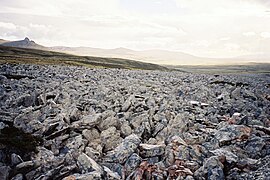
A stone run (called also stone river, stone stream or stone sea[1]) is a rock landform resulting from the erosion of particular rock varieties caused by freezing-thawing cycles in periglacial conditions during the last Ice Age.[2]
The actual formation of stone runs involved five processes: weathering, solifluction, frost heaving, frost sorting, and washing.[3] The stone runs are essentially different from moraines, rock glaciers, and rock flows or other rock phenomena involving the actual flow of rock blocks under stress that is sufficient to break down the cement or to cause crushing of the angularities and points of the boulders.[4] By contrast, the stone run boulders are fixed quite stably, providing for safer climbing and crossing of the run.
Stone runs are accumulations of boulders with no finer material between them. In the Falklands, they occur on slopes of between 1 and 10 degrees, and are the product of mass-movement and stone sorting during past periods of cold climate. They everywhere occur in association with poorly sorted, clay-rich solifluction deposits.[5]
- ^ Vitosha Nature Park: Basic Information. Landscape. Archived 2005-03-11 at the Wayback Machine Vitosha Nature Park website.
- ^ Mather, Kirtley F. (1967). Source Book in Geology, 1900-1950. Harvard University Press. pp. 125–129.
- ^ Stone, Phillip. Periglacial Princes Street - 52° South. The Edinburgh Geologist. Issue No 35, 2000.
- ^ Harris, Stuart A. Climatic Zonality of Periglacial Landforms in Mountain Areas. Arctic, Vol. 47, No. 2, June 1994, pp. 184-92.
- ^ ALDISS, D T, and EDWARDS, E J. 1999. The Geology of the Falkland Islands. British Geological Survey Technical Report, WC/99/10.